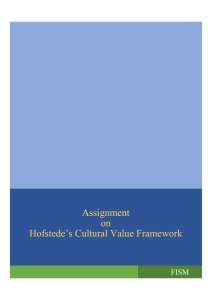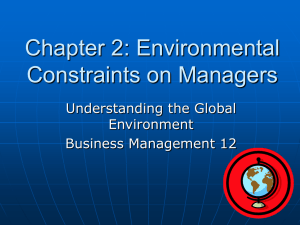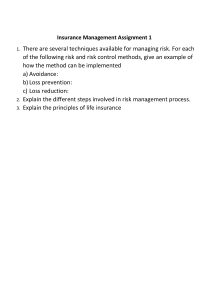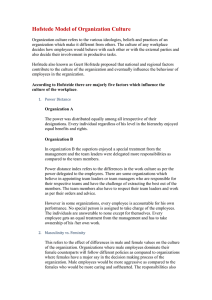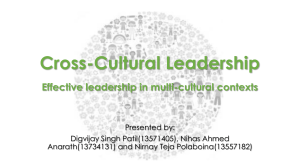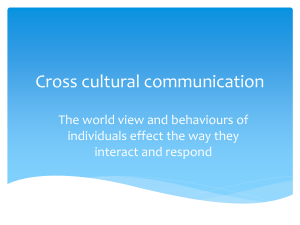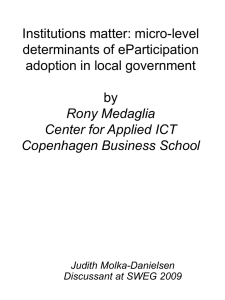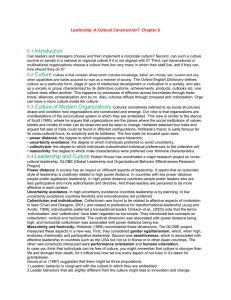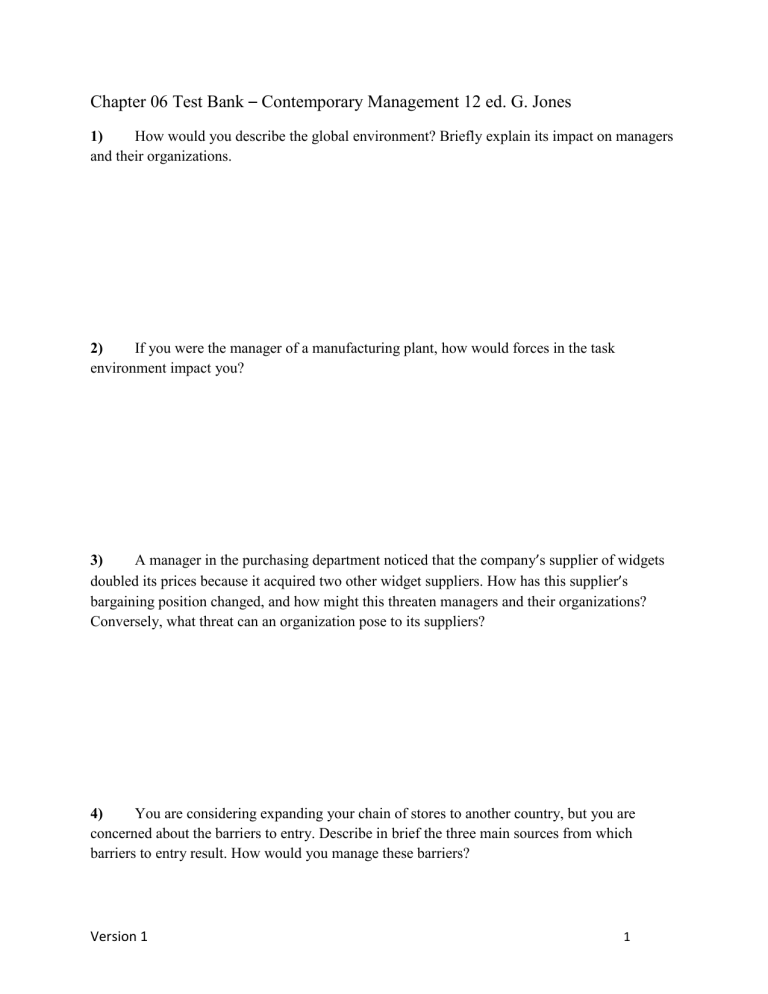
Chapter 06 Test Bank – Contemporary Management 12 ed. G. Jones 1) How would you describe the global environment? Briefly explain its impact on managers and their organizations. 2) If you were the manager of a manufacturing plant, how would forces in the task environment impact you? 3) A manager in the purchasing department noticed that the company’s supplier of widgets doubled its prices because it acquired two other widget suppliers. How has this supplier’s bargaining position changed, and how might this threaten managers and their organizations? Conversely, what threat can an organization pose to its suppliers? 4) You are considering expanding your chain of stores to another country, but you are concerned about the barriers to entry. Describe in brief the three main sources from which barriers to entry result. How would you manage these barriers? Version 1 1 5) How do the five major forces of the general environment directly or indirectly impact a business? Use your favorite business to explain your answer. 6) Define globalization and explain why the global market is becoming more open. 7) Define each of the four principal forms of capital that flow between countries and give an example of each. Explain why companies are so anxious to undertake a risk in an uncertain global environment. Version 1 2 8) Define tariffs and discuss the consequences of both increasing and removing import tariffs. 9) Briefly discuss the factors that led to the decline of distance and cultural barriers and the impact this had upon companies operating in the global environment. 10) Differentiate between values and norms and explain how they both impact national culture. 11) Use Hofstede’s five cultural dimensions to discuss how differences in these dimensions affect a manager’s ability to work with people from different cultural backgrounds. Version 1 3 12) Describe uncertainty avoidance as developed by Hofstede. Would you prefer to live in a society that is low on uncertainty avoidance, or would you want to live in a society that is high on uncertainty avoidance? Explain why. 13) How has the lowering of barriers to trade and investment affected managers’ ability to expand their businesses? 14) Describe the role that regional trade agreements like NAFTA play in a company’s decision of where to locate manufacturing and warehouse facilities. Explain how free trade areas affect business. 15) Assume you live in a society that is high on individualism and has a long-term orientation. Describe what attributes you would likely exhibit. Version 1 4 16) What benefits does the global environment offer organizations? A) The global environment provides organizations with opportunities to increase efficiency and effectiveness. B) The global environment is easy to operate within and is constant, straightforward, and predictable. C) Fluctuating sociocultural factors do not affect the performance of organizations that function at a global level. D) Organizations are faced with fewer challenges and risks when they grow to prominence internationally. E) Organizations that operate globally seldom need to compete for scarce and valuable resources. 17) The task environment includes A) the wide-ranging global, technological, sociocultural, and political forces that affect organizations. B) the forces that have the least immediate effect on managers and their decisions. C) opportunities and threats that are harder to identify than those in the general environment. D) a framework of environmental policies that dictate the CSR policies of global organizations. E) the set of forces that originate with global suppliers, distributors, customers, and competitors. 18) The general environment includes Version 1 5 A) opportunities and threats that are easier to identify and respond to than those in the task environment. B) the set of forces that originate with global suppliers, distributors, customers, and competitors. C) the wide-ranging global, technological, sociocultural, and political forces that affect organizations. D) the forces that have the most immediate effect on managers and their decisions. E) forces that have very little impact upon the performance of organizations. 19) Which statement explains how the task environment is similar to the general environment? A) They are both a set of geopolitical forces that are predictable and unchanging. B) They both present managers with few opportunities and risks when operating at a global level. C) They are both a set of forces and conditions that operate beyond an organization's boundaries. D) They both contain challenges that are easily identified and anticipated. E) They are both forces that are easy to control and have little impact on organizational performance. 20) Which statement explains how the task environment differs from the general environment? Version 1 6 A) Threats in the general environment are easier to respond to than threats in the task environment. B) Forces in the task environment have a more immediate and direct effect on managers than forces in the general environment. C) Opportunities in the task environment are less easy to identify than opportunities in the general environment. D) Unlike the task environment, the general environment deals with conditions that affect an organization's ability to obtain inputs and dispose of outputs. E) Unlike the general environment, the task environment includes the global, economic, sociocultural, political, and legal forces that affect an organization. 21) Surrey Store gets its products directly from the manufacturer and sells them to consumers. In this case, the manufacturer is a A) B) C) D) E) supplier. competitor. distributor. processor. consumer. 22) Johnson’s Furniture Factory gets its raw material from the local timber yard. The timber yard acts as Johnson’s A) B) C) D) E) 23) competitor. distributor. retailer. supplier. consumer. A supplier's bargaining position is especially strong when the input supplied Version 1 7 A) B) C) D) E) has multiple sources and channels of distribution. has inexpensive and easily available substitutes. is the sole source of that input. is found freely and can be accessed by people with little effort. is not protected by any patent. 24) Apple contracts with companies in Taiwan to make inputs such as the chips, batteries, and LCD displays that power its digital devices at lower costs. This strategy is an example of global A) B) C) D) E) exporting. franchising. importing. networking. outsourcing. 25) _______ are organizations that help other organizations sell their goods or services directly to customers. A) B) C) D) E) Producers Suppliers Distributors Manufacturers Processors 26) Gemstone designs and creates luxury items like jewelry and hair accessories. It sells its merchandise only through Francone’s, a multinational retail store. Francone’s acts as Gemstone’s Version 1 8 A) B) C) D) E) producer. supplier. distributor. manufacturer. processor. 27) _______ are individuals and groups that buy the goods and services an organization produces. A) B) C) D) E) Customers Suppliers Distributors Competitors Processors 28) Justin has a personal library with over 5,000 novels, most of them bought from Barnes and Noble. He is an example of a Barnes and Noble A) B) C) D) E) customer. supplier. distributor. competitor. processor. 29) As the only store to design and sell curtains in the suburb of Oakland, the merchandise sold by Décor and More tends to be overpriced. Noticing this, The Curtain Corner set up a showroom in the same suburb, reasoning that with lower prices, it would be able to attract more customers. The Curtain Corner is Décor and More's Version 1 9 A) B) C) D) E) partner. distributor. competitor. processor. franchiser. 30) A _______ is an organization that is NOT presently in a task environment but has the resources to enter if it so chooses. A) B) C) D) E) 31) The more difficult it is to enter the task environment, the A) B) C) D) E) 32) potential supplier potential competitor distributor supplier competitor easier it is to keep prices high. lower is the barrier to entry. harder it is to obtain customers. more competitors an organization faces. less expensive it is to enter the industry. Toy Truck operates in a task environment with a low barrier to entry; therefore, Version 1 10 A) B) C) D) E) 33) it has few competitors and faces no challenges from other organizations. it is able to sell its products easily, even though they are overpriced. the task environment is expensive to enter. the task environment is easy to enter. it is unable to obtain customers, even though it has no rivals or competitors. Candlestone operates in a task environment with a high barrier to entry, which means A) B) C) D) E) products. the task environment is inexpensive to enter. Candlestone is able to sell its products easily, even if they are overpriced. Candlestone has many competitors and faces challenges from them frequently. the task environment is easy to enter. Candlestone is unable to obtain customers, despite the excellent quality of its 34) Because Nadia wants to decrease the costs of her business, she uses _______ by choosing to buy inputs in bulk and manufacture products in large quantities. A) B) C) D) E) economic forces demographic forces potential competitors brand positioning economies of scale 35) Brand _______ refers to customers' preference for the products of organizations currently in the task environment. Version 1 11 A) B) C) D) E) recognition positioning loyalty saturation awareness 36) Seafood Diner, a seafood restaurant chain, opened its newest restaurant in a small town. It soon found that the only customers it attracted were tourists because the locals preferred to go to The Clam Shack—an older but more expensive restaurant. The Clam Shack enjoyed significant brand A) B) C) D) E) saturation. emersion. loyalty. dilution. acceleration. 37) The most potentially threatening force that managers must deal with in the task environment is A) B) C) D) E) 38) rivalry between competitors. managing the global supply chain. negotiating and administering agreements with unions and their representatives. a reliable supply of input resources. a distributor demands that the company reduces the prices of its goods and services. Caste systems in India are examples of Version 1 12 A) B) C) D) E) 39) cultural imperialism. cultural pluralism. national culture. social structure. social relativism. Being a large powerful retailer, Walmart has done each of these, EXCEPT which one? A) Walmart has controlled its suppliers' access to customers by demanding suppliers reduce their prices. B) Walmart has demanded that their overseas suppliers pay their workers based on U.S. standards. C) Walmart has bought only from competitors of a supplier, if the supplier refuses to reduce their prices. D) Walmart has demanded additional fees from U.S. suppliers for using its distribution centers and warehouses. E) Walmart has changed the frequency of payment to some vendors, tying payments to how quickly a supplier’s inventory is bought. 40) _______ is the set of values and the norms of behavior which are approved or sanctioned by a particular society. A) B) C) D) E) 41) National culture Social stratification Cultural pluralism Organizational culture Social structure Inflation is an example of a(n) _______ force in an organization's environment. Version 1 13 A) B) C) D) E) social economic demographic ergonomic legal 42) _______ forces are outcomes of changes in the skills and equipment managers use to design, produce, or distribute goods and services. A) B) C) D) E) Cultural Political Demographic Technological Sociocultural 43) Standard Power is a new company in the electrical industry, and with the company’s success, it is building a strong reputation. What impact will this company most likely have on the other companies in the electrical industry? A) B) C) D) E) Prices and profits will increase. Competition will decrease. Competition will increase and prices and profits will decrease. Competition will decrease and prices and profits will increase. The new company will not have an impact on the other companies. 44) Unlike previous generations, salespeople today can work from home offices, communicate with colleagues in different parts of the world almost instantly, and commute electronically to work. This flexibility is due to changes in _______ forces. Version 1 14 A) B) C) D) E) economic political demographic technological sociocultural 45) Noreen is a member of an egalitarian culture, one in which few distinctions are made between individuals and groups. Her culture is low on A) B) C) D) E) cultural diversity. gender equality. national culture. social stratification. cultural pluralism. 46) Violette is the CEO of Lafarge Advertising, based in Paris. Many distinctions exist between the different classes of people in her society. Most of the top managers in her organization, for example, come from the upper classes. This implies that French society has a high degree of A) B) C) D) E) social stratification. gender inequality. cultural imperialism. cultural pluralism. economic equality. 47) Garry is a member of a society that makes very few distinctions between people and groups. This is reflected in his company, the managers of which represent several different classes and cultures. The society to which Garry belongs is Version 1 15 A) B) C) D) E) low on cultural diversity. low on social stratification. high on economic inequality. high on race discrimination. low on cultural pluralism. 48) Which type of forces are outcomes of changes in or changing attitudes toward the characteristics of a population? A) B) C) D) E) demographic terminal ethnographic geopolitical instrumental 49) A decline in the number of young people joining the workforce and an increase in the number of active employees who are postponing retirement are examples of _______ forces affecting the workforce. A) B) C) D) E) 50) demographic terminal ethnographic geopolitical instrumental _______ forces are outcomes of the changes in the laws and regulations of a society. Version 1 16 A) B) C) D) E) Technological Political and legal Economic Demographic Sociocultural 51) Due to changing _______ forces, Constantine’s oil company benefited greatly from decreased regulation of his industry. A) B) C) D) E) 52) sociocultural political and legal technological ethnographic demographic An effect of globalization is it A) B) C) D) E) increases similarities between members of nations. prevents the economic systems of different countries from merging with each other. decreases the interconnectedness of the world's markets and businesses. decreases organizational efficiency and effectiveness. hinders the flow of financial and resource capital between countries. 53) If Malaysian companies are highly efficient in the production of textiles and U.S. companies are highly efficient in the production of computer software, under a _______ agreement, capital would move to Malaysia and be invested there to produce textiles, while capital from around the world would flow to the United States and be invested in its innovative software companies. Version 1 17 A) B) C) D) E) 54) _______ capital is most affected by immigration and emigration. A) B) C) D) E) 55) aid. free-trade tariff restricted-trade regional-trade national culture Human Virtual Political Resource Financial _______ capital flows through the processes of overseas investment, credit, lending, and A) B) C) D) E) Human Technological Political Resource Financial 56) The Republic of Somalina has been losing capital to other countries steadily over the last five years. What is likely to happen as a result? Version 1 18 A) B) C) D) E) 57) Its rate of unemployment will be decreased. The standard of living will fall. The impact of the recession will be lessened. The gap between the rich and poor will narrow. Its economy will stabilize. Political capital is the flow of A) people around the world through immigration, migration, and emigration. B) natural resources, parts, and components between companies and countries. C) information and data across the world through the social media. D) money across world markets through overseas investment, credit, lending, and aid. E) power and influence around the world using diplomacy, persuasion, aggression, and force of arms. 58) When the United States sent military troops into Iraq, it was using _______ capital to influence policy. A) B) C) D) E) 59) power natural resource social economic political What factor played an important role in speeding up globalization? Version 1 19 A) B) products C) the world D) E) increased government-enforced import tariffs that protected the domestic economy export restrictions which ensured that the people of a country had access to their own declining barriers to trade and investment that eased the flow of capital throughout rejection of the free-trade doctrine, which increased global outsourcing fortification of trade and investment barriers between each country 60) The lowering of barriers of distance and culture affecting global organizations has been caused in part by the A) B) C) D) E) 61) imposition of government-enforced tariffs on imports. advancements of communication and transportation technology. rejection of the free-trade doctrine. imposition of government-enforced tariffs on exports. restrictions placed on the flow of capital between nations. Regional trade agreements may A) enforce regional restrictions on the cross-border flow of resources and reinforce import tariffs. B) expose companies based in one member country to increased competition from companies in other member countries. C) hinder the spread of globalization by setting up trade barriers between different countries of the same region. D) provide manufacturing organizations with fewer opportunities to reduce costs and provide managers with fewer threats. E) be created to reduce overall tariffs on goods that flow within a country and increase tariffs on goods that flow between regions. Version 1 20 62) What is an advantage of free-trade agreements? A) They protect domestic industries and jobs by taxing goods imported from outlying regions. B) They protect the well-being of people by restricting the flow of goods being exported from their country. C) They reduce the impact of globalization by preventing the loss of capital from a country. D) They provide managers with a threat-free environment to work within. E) They provide manufacturing organizations with opportunities to reduce production costs. 63) NAFTA is an example of a A) B) C) D) E) 64) regional free-trade agreement. global financial institution. collective bargaining agreement. protective tariff agreement. military alliance. The basic building blocks of national culture are A) B) C) D) E) values and norms. political and legal forces. ethnographic forces. corporate values and organizational culture. the task and general environment. 65) _______ are beliefs about what a society considers to be good, right, desirable, or beautiful. Version 1 21 A) B) C) D) E) 66) Folkways Values Laws Traditions Mores Values are A) B) C) D) E) static and resistant to change. invested with emotional significance. universally held beliefs and the same across all societies. easily changed and the changes are easily accepted. superficial in a society's belief system. 67) _______ are unwritten, informal codes of conduct that shape the behavior of people toward one another and are held important by most members of a group or organization. A) B) C) D) E) Laws Policies Norms Values Philosophies 68) Proscriptions against murder, theft, and adultery are _______ that are central to the functioning of society. Version 1 22 A) B) C) D) E) mores folkways values laws superstitions 69) Donnie was caught stealing power tools from his next-door neighbor. What type of norm did Donnie violate? A) B) C) D) E) 70) Examples of mores are A) B) C) D) E) 71) mores folkways values morals superstitions societal taboos which censure murder, theft, and incest. social conventions that dictate the usage of different types of cutlery. customs that govern social interaction between neighbors. traditions that prescribe gender-appropriate clothing in social gatherings. superstitions held important by different members of a society. Examples of folkways are Version 1 23 A) B) C) D) E) 72) People who violate folkways are often thought to be A) B) C) D) E) 73) immoral. unethical. ill-mannered. criminals. mean. According to Hofstede, individualist societies A) B) C) D) E) 74) laws in a country which make divorce permissible. societal taboos that prohibit murder, theft, and incest. religious doctrines that forbid the consumption of particular types of food. laws that prescribe punishments for different types of offenses. societal conventions that concern gender-appropriate clothing. value societal welfare over that of individual members of society. value personal freedom, personal success, and self-expression. emphasize subordination of the individual to the goals of the group. emphasize conformity to group norms and strong identification with the group. require individuals to put the needs of the group before their own. Hofstede defined collectivist societies as those that Version 1 24 A) emphasize self-expression, personal freedom, and individual rights. B) adhere to the principle that people should be judged by their contribution to the group. C) discourage individuals from placing societal welfare above their own. D) encourage the pursuit of individual goals and individual entrepreneurship. E) adhere to the principle that people should be judged by their individual achievements. 75) By _____, Hofstede was referring to the degree to which societies accept the idea that inequalities in the power and well-being of their citizens are due to differences in individuals’ physical and intellectual capabilities and heritage. A) B) C) D) E) power distance individualism collectivism uncertainty avoidance long-term orientation 76) Hayato was raised to believe that the individual is less important than the group as a whole. He also believes that physical and intellectual capabilities and heritage account for the inequality in the power and well-being of members of his society. Hayato's society is A) B) C) D) E) 77) high on power distance and low on individualism. low on power distance and low on collectivism. high on individualism and low on achievement orientation. low on collectivism and low on achievement orientation. low on power distance and low on individualism. Hofstede’s model defined societies with high power distance as having Version 1 25 A) B) C) D) E) 78) no inequalities between different classes in society. a government that uses taxation and social welfare programs to reduce inequality. inequalities in the well-being of individuals due to their work achievements. a large gap between rich and poor. resources that are accessible to all members of society. Societies with low power distance have been defined by Hofstede as those in which A) B) C) D) E) large inequalities between different classes in society are allowed to develop. the government uses taxation and social welfare programs to reduce inequality. inequalities in the well-being of individuals are due to their birth and heritage. the gap between the rich and poor grows very large. professional workers amass wealth. 79) Susie belongs to a society that values assertiveness, performance, competition, and results. Her society also encourages freedom of expression and personal success but makes few provisions for the welfare of the weak. According to Hofstede's model of national culture, what is true about her society? A) B) C) D) E) It has an achievement orientation and is high on individualism. It has an achievement orientation and is high on collectivism. It has a nurturing orientation and is low on individualism. It has a nurturing orientation and is low on performance orientation. It has a performance orientation and is high on collectivism. 80) Batu belongs to a society that is rigid and skeptical about people whose behaviors or beliefs differ from the norm. His society also values warm, personal relationships over success and performance. According to Hofstede's model of national culture, what is true about his society? Version 1 26 A) B) C) D) E) It is low on uncertainty avoidance and has an achievement orientation. It is high on uncertainty avoidance and has a nurturing orientation. It is low on uncertainty avoidance and has a performance orientation. It is high on uncertainty avoidance and has an achievement orientation. It is low on uncertainty avoidance and has a nurturing orientation. 81) Chin-Mae belongs to a culture that values the subordination of individuals to the group. The national culture also values personal stability and doesn’t focus on the future. According to Hofstede, what is true about Chin-Mae's culture? A) B) C) D) E) 82) According to Hofstede, countries with a long-term orientation A) B) C) D) E) 83) It is high on individualism and has a long-term orientation. It is low on collectivism and has a long-term orientation. It is high on individualism and has a short-term orientation. It is high on collectivism and has a short-term orientation. It is low on collectivism and has a short-term orientation. have a high rate of per capita savings. have citizens who prioritize happiness over achievement and perseverance. have citizens who live for the present and value personal stability. have citizens who tend to spend more and save less. foster organizations that emphasize immediate results over year-end goals. In Western cultures, an example of individualism values is Version 1 27 A) B) C) D) E) 84) Collectivism values include A) B) C) D) E) 85) a tolerance of differences in personal beliefs. warm personal relationships being important. persistence in achieving goals. the subordination of the individual to the goals of the group. a high regard for individual entrepreneurs. assertiveness. warm personal relationships. persistence in achieving goals. subordination of the individual to the goals of the group. a high regard for self-expression. Hofstede’s nurturing orientation values A) B) C) D) E) diversity. assertiveness. warm personal friendships. performance. achievement. 86) Which organization demonstrates Hofstede’s cultural dimension of a short-term orientation? Version 1 28 A) Mary’s Magnets, with its large amount of cash on hand for future purchases B) John’s Tacos, with a strict policy of not spending time on anything that will not help the company achieve its goals C) Barbara’s Bangles, a company that encourages its employees to have a high rate of savings for retirement D) Cho’s Chalupas, a pop-up store that moves every two weeks to a new location (her employees love it!) E) The Restoration Place, whose owner, Kylie, doesn’t care if her employees are happy as long as they are productive and make her money 87) The GLOBE Project’s cultural dimension of _______ focuses on the degree to which individuals express pride, loyalty, and cohesiveness in their organizations or families. A) B) C) D) E) in-group collectivism institutional collectivism assertiveness performance orientation humane orientation 88) Taryn’s organization places high value on employees who are confrontational and aggressive in their relationships with others. The GLOBE Project would rate this organization as high in which cultural dimension? A) B) C) D) E) Version 1 uncertainty avoidance institutional collectivism assertiveness performance orientation humane orientation 29 89) Which cultural dimension in the GLOBE Project is being demonstrated by an organization that encourages and rewards individuals for being fair, altruistic, generous, caring, and kind to others? A) B) C) D) E) in-group collectivism future orientation gender egalitarianism performance orientation humane orientation 90) Which organization is demonstrating the GLOBE Project’s cultural dimension of institutional collectivism? A) Company A encourages all employees to recycle by providing receptacles in all common areas and giving a prize to the department that recycles the most material each month. B) Company G requires all employees to attend a seminar on sexual harassment. C) Company J provides a generous matching 401(k) program to encourage its employees to save for retirement. D) Company O gives bonuses for sales beyond set quotas. E) Company X encourages its employees to compete for promotions and salary increases. 91) Which organization is demonstrating the GLOBE Project’s cultural dimension of uncertainty avoidance? Version 1 30 A) Company A encourages all employees to recycle by providing receptacles in all common areas and giving a prize to the department that recycles the most material each month. B) Company G requires all employees to attend a seminar on sexual harassment. C) Company J provides a generous matching 401(k) program to encourage its employees to save for retirement. D) Company O gives bonuses for sales beyond set quotas. E) Company Y has a rules and regulations book that all employees are required to read and follow. 92) A company must operate in more than two countries around the world to be considered a global organization. <b></b> ⊚ ⊚ true false 93) Opportunities and threats that result from changes in the task environment are easier to identify and respond to than events in the general environment. ⊚ ⊚ 94) true false A high level of rivalry typically results in price competition that increases existing prices. ⊚ ⊚ true false 95) ABC Corp. has developed economies of scale, which lower the barriers to entry for new competitors. ⊚ ⊚ Version 1 true false 31 96) The aging of the population of a country is an example of a demographic force that affects organizations in the country. ⊚ ⊚ true false 97) Nations forming unions, such as the EU, that allow free exchange of resources and capital are examples of the political and legal forces in the environment. ⊚ ⊚ true false 98) Falling trade barriers pose a serious threat to the nation's domestic market because they increase competition in the task environment. ⊚ ⊚ 99) true false Globalization has decreased the levels of interdependence between people and nations. ⊚ ⊚ true false 100) The aim of import tariffs is to encourage the entry of foreign goods into a country's market. ⊚ ⊚ Version 1 true false 32 101) According to Hofstede, low-power-distance countries’ societies prevent a large gap between rich and poor and minimize inequalities between different classes of citizens. ⊚ ⊚ Version 1 true false 33 Answer Key Test name: Chapter 06 Test Bank 16) A 17) E 18) C 19) C 20) B 21) A 22) D 23) C 24) E 25) C 26) C 27) A 28) A 29) C 30) B 31) A 32) D 33) B 34) E 35) C 36) C 37) A 38) D 39) B 40) A 41) B 42) D 43) C 44) D 45) D 46) A 47) B 48) A 49) A 50) B 51) B 52) A 53) A 54) A 55) E 56) B 57) E 58) E 59) C 60) B Version 1 34 61) B 62) E 63) A 64) A 65) B 66) B 67) C 68) A 69) A 70) A 71) E 72) C 73) B 74) B 75) A 76) A 77) D 78) B 79) A 80) B 81) D 82) A 83) E 84) D 85) C 86) D 87) A 88) C 89) E 90) A 91) E 92) FALSE 93) TRUE 94) FALSE 95) FALSE 96) TRUE 97) TRUE 98) TRUE 99) FALSE 100) FALSE 101) TRUE Version 1 35
